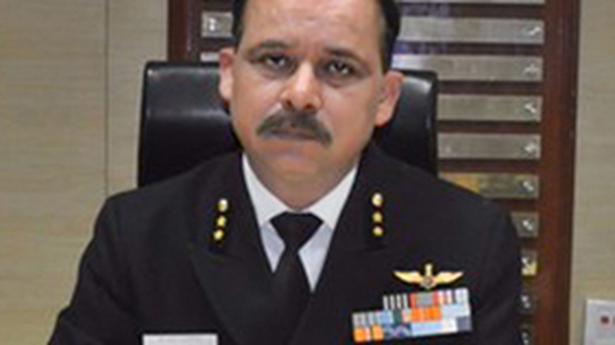On his first visit to Kerala after taking over as the Director-General of Indian Coast Guard, V.S. Pathania spoke on the maritime force’s capabilities, goals and plans. Excerpts:
There seems to be a rise in drug trafficking on the seas of India’s maritime interest going by the recent hauls made by you. How rampant is the problem?
When I joined the Coast Guard 36 years ago, smuggling of gold, electronic items and drug running along the seas used to be a regular phenomenon. In fact, the requirement to set up the Coast Guard as a separate armed force under the Ministry of Defence was itself felt in view of such activities. But thanks to our efforts, smuggling came down to almost zero by the late 1990s. However, our efforts never died down. And after the 26/11 attacks, we got an exponential increase in force levels and manpower and today, we have 159 ships and 74 aircraft. Although we are thin in terms of manpower, what we have today meets out requirements.
Since our presence at sea has been enhanced, the vessels trying to smuggle drugs — either from Iran or from the African coast — take a detour, go west and then try to come east. But whoever comes straight gets apprehended. We are in touch with the countries in our neighbourhood because the aim of drug traffickers is to move it to the east. India could be a transit point. We cooperate with other Coast Guards in the region in information-sharing. Equally, there’s an understanding between intelligence agencies and the Coast Guard and the apprehensions are a result of jointmanship. So, capacity and capability building have given a fillip to such operations.
I maintain 60 ships at sea, on either seaboards and off the Andamans, at any point of time. Further, we launch about 12 to 14 maritime sorties daily and each sortie lasts about 4.5 to 5 hours. With our presence and capability — we are getting equipped with more platforms — we have the capability to reassign ships and aircraft for fresh tasks.
You have now got two squadrons of ALH (Advanced Light Helicopter) Mk-III helicopters, in Bhubaneshwar and Kochi. How has that augmented your capabilities?
The aircraft come with advanced sensors and are capable of detecting oil spills; detecting, tracking and relaying movements at sea; and have a radar to scan. If using the single-engine helicopter we could only pick up one person earlier, we can now pick up two together using a rescue bucket. The helicopter has an endurance of about 4.5 hours. We have begun to embark them on our vessels. This has enhanced our radius of operation.
Could you elaborate more on your cooperation with other Coast Guards in the region?
We have three Maritime Rescue Coordination Centre that are internationally connected. These have maritime rescue sub-centres under them and the information flow is really fast. So, information about anything that happens at sea, regardless of whether or not it’s in Indian waters, gets shared. We also do exercises with Coast Guards of Indian Ocean littorals such as Sri Lanka and the Maldives. Called Dosti, it’s conducted biennially and ships from the three countries take part in it, the Director-Generals meet, there are pollution control exercises and lectures on maritime law enforcement and the like.
Since you keep interacting, you have a line of communication. The roles of the Coast Guards are similar and therefore, we also exercise with Bangladesh and Mauritius Coast Guards. Then there’s an annual exercise undertaken with Japan.
Isn’t there a spike in marine pollution of late?
It’s one of our serious concerns. While we do regular pollution control exercises, we saw live action in the last one-and-a-half years when two vessels caught fire off the coast of Sri Lanka. We now have three purpose-built vessels to fight pollution. We are getting two more built at Goa Shipyard and their construction is under way. I have five commands with me and I’ll be able to give each one ship, thereby making the response much faster.
With a spurt in natural disasters, how ready are you to carry out search and rescue (SAR) operations?
Our SAR capability has been strengthened all along the coast. For instance, I can simultaneously launch all the four ALH Mk-III helicopters of the new squadron in Kerala in case of an emergency. There’s a dedicated Coast Guard jetty at Cochin Port to berth more vessels and a second one is coming up at Vizhinjam near Thiruvananthapuram. We are upgrading our Dornier patrol aircraft — instrumentation and capability-wise. The initial work order for 12 aircraft has been given to the Hindustan Aeronautics Ltd. and we will systematically upgrade all our 39 Dorniers.
What’s the status of work on the Coast Guard Academy coming up in Mangaluru?
We have started work on the academy being set up on the banks of a river adjacent to the Mangaluru airport with the anticipation that it will be in place in the next three to four years. It’s a high-value project with schools for maritime law enforcement, search and rescue, oil pollution response and the like. It will not be a basic training academy, but one for advanced studies. We will offer this facility to the Navy, Customs, Marine Police and to the foreign Coast Guards. As on date, our training is on a smaller scale in Kochi at the Coast Guard training centre.




